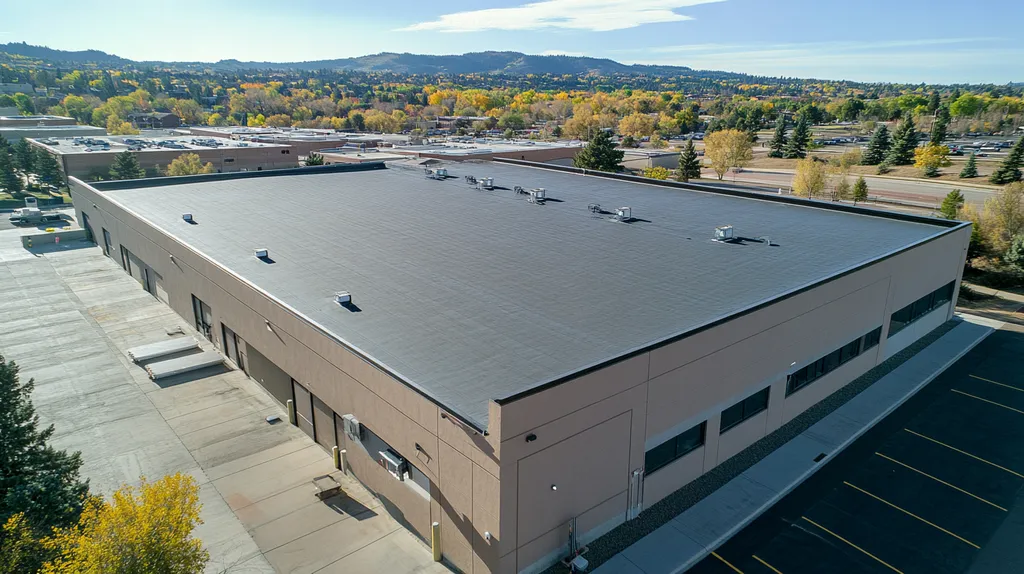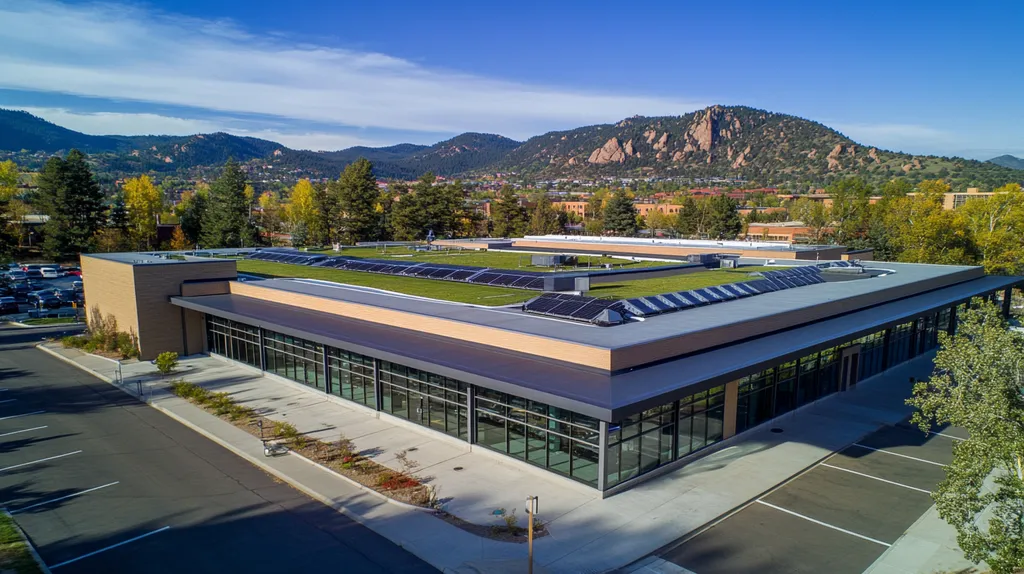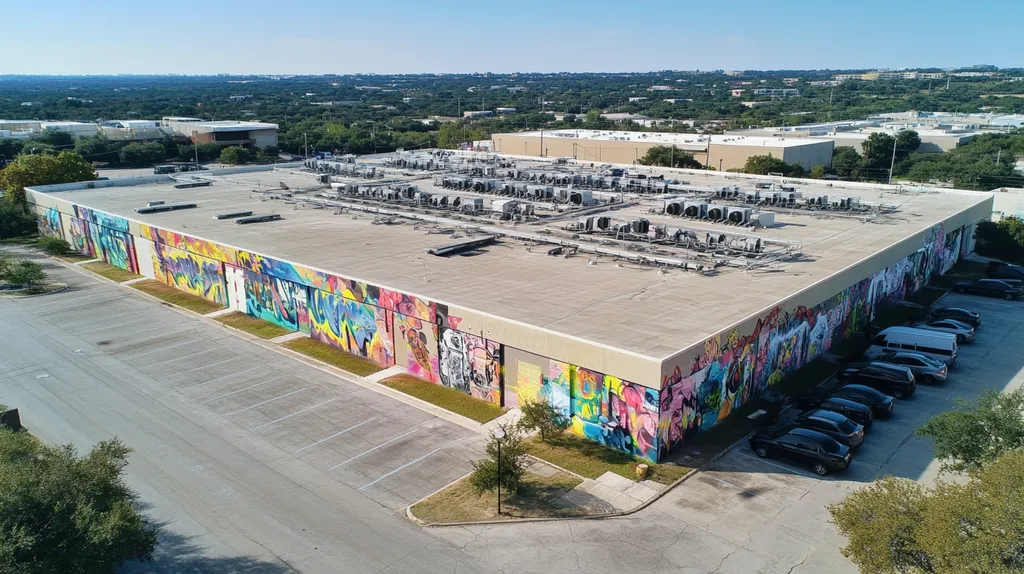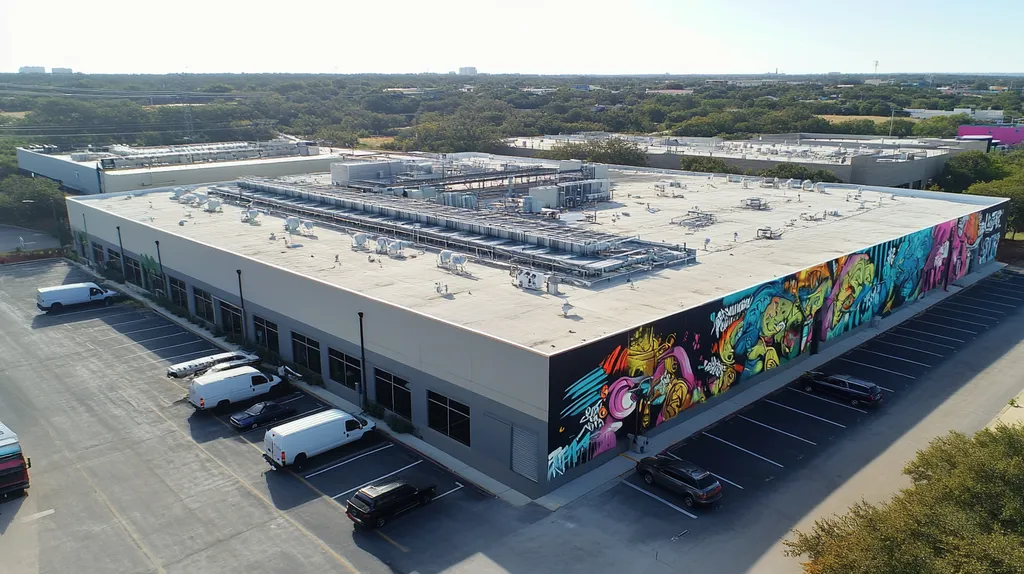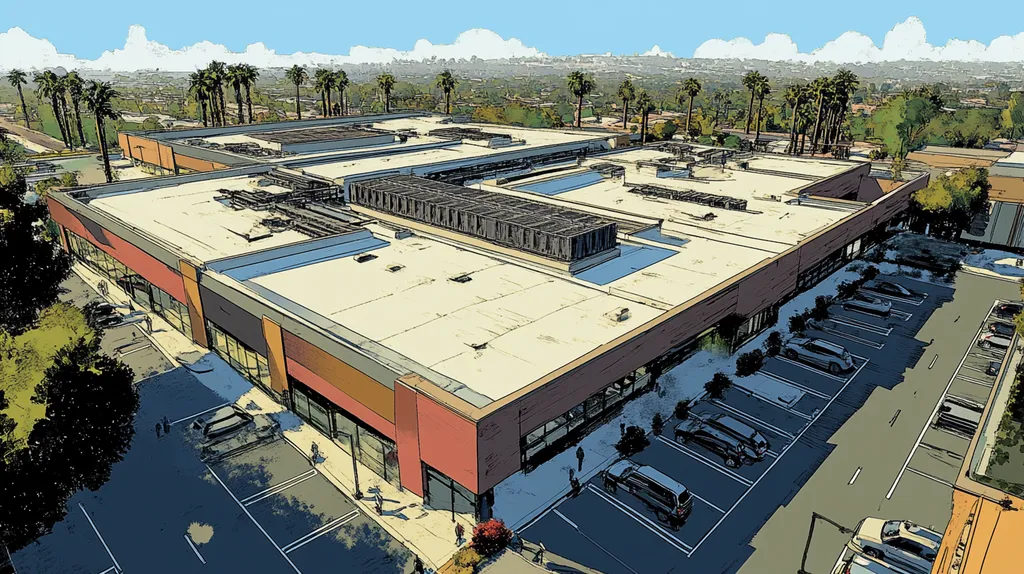While commercial roofs silently battle the elements 24/7, a shocking 85% of premature roof failures stem from outdated inspection practices that miss critical warning signs. It’s like using a 1980s maintenance manual to service a modern smartphone – inadequate and potentially catastrophic.
From rigid scheduling that ignores building-specific needs to superficial “walk and chalk” inspections that miss underlying issues, traditional maintenance approaches are costing property owners millions in preventable repairs.
This analysis exposes the hidden flaws in conventional roof maintenance while revealing how data-driven strategies and modern technology are revolutionizing commercial roof care.
SECTION 1: CURRENT PRACTICES
Did you know your commercial roof is doing more than just keeping the rain out? It’s playing an epic game of environmental defense, battling UV rays, chemical pollutants, and whatever Mother Nature throws its way. Yet surprisingly, many building owners treat roof maintenance like a “set it and forget it” infomercial product. Current inspection and maintenance practices often miss critical warning signs, leading to premature roof failure and expensive emergency repairs.
Routine Inspection Protocols
Think of your roof inspection protocol as your building’s health check-up. Just as skipping doctor visits can lead to undetected health issues, inadequate roof inspections can mask developing problems until they become catastrophic.
The current bi-annual inspection model (spring and fall) treats every roof the same way. This cookie-cutter approach ignores crucial factors like local climate patterns, nearby tree coverage, and building-specific stress points.
Many inspection checklists read like they were written in the 1980s, focusing solely on visible surface issues. They often miss modern roofing system complexities, such as integrated solar installations or green roof components.
Most concerning is the widespread “walk and chalk” approach, where inspectors simply circle visible problems with chalk. This superficial method can miss underlying issues that could turn your roof into an expensive replacement project.
Standard Maintenance Schedules
A sound facilities maintenance plan isn’t just about following a calendar – it’s about protecting your investment and preventing costly repairs. A proactive approach to maintenance can significantly extend your roof’s lifespan and preserve warranties. (source: National Center for Education Statistics)
Current maintenance schedules often operate like a fast-food drive-through: quick, standardized, and lacking customization. These one-size-fits-all approaches ignore crucial variables like foot traffic patterns, HVAC placement, and unique architectural features.
Weather events don’t follow your maintenance calendar. Yet many facilities stick rigidly to pre-scheduled maintenance dates, even when storms, extreme temperatures, or unusual conditions suggest immediate attention is needed.
The gap between scheduled maintenance visits often becomes a breeding ground for small problems to evolve into major headaches. Without regular monitoring, minor issues like clogged drains can escalate into structural nightmares.
Common Inspection Tools Used
If your roof inspector shows up with just a clipboard and camera, they’re bringing a slingshot to a laser gun fight. Modern roofing systems demand sophisticated diagnostic tools, yet many inspections rely on outdated equipment.
Traditional moisture meters only detect problems after water has already infiltrated your roofing system. It’s like waiting until your basement floods to check for foundation cracks – too little, too late.
Even when advanced tools like infrared cameras are used, they’re often employed in isolation. This piecemeal approach misses the bigger picture, like trying to diagnose engine trouble by only checking the oil.
The lack of integrated digital documentation means valuable inspection data often gets lost in filing cabinets or scattered across multiple platforms. Without proper data tracking, identifying patterns and preventing recurring issues becomes nearly impossible.
SECTION 2: SYSTEMIC ISSUES
Think your roof is just hanging out up there, minding its own business? Think again! Your commercial roof is working overtime as your building’s bouncer, keeping out everything from acid rain to UV rays. Yet many building owners treat their roofs like a forgotten houseplant – checking on it only when it starts showing obvious signs of distress. The reality? A whopping 85% of commercial roof failures could have been prevented with proper inspection practices.
Inadequate Inspection Frequency
Your roof faces more daily drama than a reality TV show. From scorching heat waves to freeze-thaw cycles, it’s constantly dealing with environmental plot twists that can fast-track deterioration.
That annual spring inspection? It’s like checking your teeth just once a year and hoping nothing goes wrong. Different roof sections age at different rates, especially around HVAC units, drainage areas, and high-traffic zones.
While some areas might cruise along happily for months, others could be secretly hosting their own water park party. Without frequent targeted inspections, these trouble spots can turn into expensive surprises.
Smart property managers are ditching the calendar-based approach for a more dynamic inspection schedule that responds to weather events, usage patterns, and equipment installations.
Hidden Flaws in Standard Practices
Current inspection methods often have more blind spots than a vintage car. The typical “walk and chalk” approach is about as effective as trying to diagnose engine trouble by just looking at the hood.
Most inspectors focus on obvious surface issues while missing the sneaky problems lurking beneath. It’s like ignoring termites because the paint looks fresh – those hidden issues are quietly throwing a demolition party.
Modern roofing systems are complex ecosystems of materials, each with their own quirks and vulnerabilities. Yet many inspection protocols still treat them like they’re simple tar-and-gravel setups from the 1970s.
The real kicker? Many “comprehensive” inspections skip crucial areas like flashing details, membrane seams, and drainage patterns – basically giving problem spots a free pass to cause chaos.
Cost Implications of Inefficiencies
Let’s talk money – because inefficient roof maintenance isn’t just leaking water, it’s leaking dollars. Small problems that could be fixed for hundreds can balloon into five-figure nightmares faster than you can say “total replacement.”
A sound facilities maintenance plan isn’t just about following a calendar – it’s about protecting your investment and preventing costly repairs. By implementing proactive maintenance strategies, facility managers can significantly extend roof lifespan while preserving valuable warranties. (source: National Center for Education Statistics)
Emergency repairs often cost 3-5 times more than planned maintenance. That’s like paying resort prices for a motel experience – and getting soaked in more ways than one.
Factor in business disruption, inventory damage, and potential liability issues, and suddenly those “cost-saving” inspection shortcuts start looking more expensive than a gold-plated garden hose.
SECTION 3: MISSED OPPORTUNITIES
Your commercial roof is like a 24/7 bouncer at an exclusive club – keeping out unwanted elements while protecting what’s valuable inside. Yet many building owners are missing golden opportunities to extend their roof’s VIP career. Would you believe that 60% of commercial roofs retire early due to neglected maintenance? It’s like forcing your star player to bench-warm until they quit the team. Let’s explore how these missed opportunities are costing businesses more than just leaked rainwater.
Preventive Maintenance Overlooked
Think of your roof as a premium sports car – it needs regular tune-ups to maintain peak performance. Yet many property managers treat it more like a rental car, ignoring minor issues until they snowball into major problems.
Those tiny blisters in your membrane? They’re like tiny time bombs, quietly counting down to an expensive surprise party nobody wants to attend. Without regular check-ups, these silent troublemakers multiply faster than rabbits in springtime.
Here’s the kicker: fixing a small problem today might cost you hundreds, but wait a few months and watch that number sprout more zeros than a binary code. It’s simple math that too many buildings are getting wrong.
Most frustrating? Many warranty claims get denied because nobody bothered to document routine maintenance. It’s like throwing away free insurance just because you didn’t want to file the paperwork.
Early Detection of Leaks Missed
Water is sneakier than a cat burglar in velvet socks – by the time you see it dripping from your ceiling, it’s already hosted a pool party in your insulation. Modern leak detection should be more CSI than hide-and-seek.
Those mysterious stains on your interior walls? They’re like forensic evidence, telling a story of water infiltration that started months ago. But without regular inspections, you’re missing all the early chapters.
Even tiny leaks can turn your building into an unofficial indoor water park. A single drip can travel sideways for yards before making its grand entrance through your ceiling tiles.
The real tragedy? Most leaks announce themselves with subtle hints long before they become headline news. But without someone actively looking for these clues, they’re about as useful as a submarine with screen doors.
Potential for Extended Roof Lifespan
A well-maintained commercial roof is like a marathon runner – with proper training and care, it can go the distance. Yet many buildings are treating their roofs like they’re in a sprint, burning through their potential lifespan at record speed.
Modern roofing systems are engineered to last 20-30 years, but neglect can cut that number in half faster than you can say “total replacement.” It’s like buying a Rolls Royce and treating it like a demolition derby car.
Those fancy UV-resistant materials and high-tech membranes? They’re not magic shields that work forever without maintenance. Even Superman needs occasional downtime, and your roof is no different.
Smart property managers are discovering that regular maintenance isn’t just about preventing problems – it’s about maximizing investment. Each year of extended life means thousands in delayed replacement costs.
Energy efficiency bonuses? A well-maintained roof keeps your HVAC system from working harder than a personal trainer in January. That means lower utility bills and a happier bottom line.
SECTION 4: ROOT CAUSES
Ever wonder why commercial roofs fail faster than a chocolate teapot? The answer lies not in the clouds, but in how we approach roof maintenance. Your roof is playing a high-stakes game of environmental defense, yet many buildings treat it like an afterthought. Just as a chain is only as strong as its weakest link, your roof’s performance depends on addressing these fundamental issues that plague commercial roof maintenance.
Insufficient Budget Allocation
Picture your roof budget as a tiny umbrella trying to shelter an elephant – it’s just not going to provide adequate coverage. Most facilities allocate less than 2% of their operating budget to roof maintenance, treating their most critical defensive asset like a casual expense.
This penny-wise, pound-foolish approach creates a dangerous cycle. When budgets get tight, roof maintenance often gets the first cut, like trimming your parachute to save weight.
Emergency repairs end up consuming three to five times more budget than planned maintenance would have required. It’s like paying for a complete engine replacement because you skipped a few oil changes.
The ultimate irony? Those “budget-saving” cuts typically lead to premature roof replacement, turning your five-figure maintenance budget into a six-figure capital expense.
Lack of Training for Inspectors
Today’s commercial roofs are more complex than a space shuttle’s heat shields, yet many inspectors are armed with knowledge from the shingle-and-tar era. Modern roofing systems demand sophisticated understanding, not just a good pair of boots.
Most in-house maintenance teams receive less than eight hours of roofing-specific training annually. That’s like sending someone to perform heart surgery after watching a few YouTube tutorials.
The technology gap is equally concerning. Many inspectors lack training on modern diagnostic tools, reducing their effectiveness to that of a weather forecaster without radar.
Without ongoing education, inspectors often miss subtle warning signs that could prevent major failures. It’s like having a medical checkup from someone who hasn’t updated their medical knowledge since the 1980s.
Incomplete Inspection Checklists
Many current inspection checklists are about as complete as a puzzle missing half its pieces. They focus on obvious surface issues while ignoring critical system components that could be screaming for attention.
These outdated checklists often skip crucial modern roofing elements like solar panel attachments, green roof components, and advanced drainage systems. It’s like having a pilot’s pre-flight checklist that doesn’t mention the engines.
Documentation requirements are typically vague and inconsistent, leaving future inspectors playing detective with incomplete information. Without proper historical data, identifying patterns becomes as challenging as solving a mystery with half the clues missing.
Most concerning is the lack of customization for specific roof types and local climate conditions. Using a one-size-fits-all checklist in roofing is like using the same recipe to bake every type of bread – it just doesn’t work.
DATA DRIVEN EVIDENCE
Want to see your facility budget perform a disappearing act? Just ignore your roof maintenance! The numbers tell a shocking story: commercial buildings that skip regular inspections end up spending nearly triple on emergency repairs compared to their proactive counterparts. It’s like watching money fly off your roof – literally. Let’s crunch some numbers that’ll make even your accountant’s calculator blush.
Cost-Benefit Analysis of Regular Inspections
Think your roof inspections are expensive? Try pricing a full replacement! Data shows that every dollar spent on preventive maintenance saves $7-10 in reactive repairs. That’s better returns than most Wall Street wizards can promise.
Those quarterly inspections might cost you $500-1,000 each, but they’re catching problems when they’re the size of a coffee cup, not a swimming pool. Emergency repairs typically run 300% higher than planned maintenance work.
Here’s a number that’ll wake you up: 90% of commercial roofs develop problems within the first 5 years. Regular inspections catch these issues when they’re still wearing training wheels, not after they’ve grown into budget-crushing monsters.
The math gets even better when you factor in business disruption costs. A planned repair takes hours; an emergency fix can shut down operations for days or weeks. Your profit margins will thank you for choosing the former.
Impact of Neglect on Roof Longevity
Your roof is playing a high-stakes game of “Beat the Clock” – and neglect is helping Father Time win. Data shows that unmaintained roofs typically reach only 60% of their expected lifespan, turning your 20-year investment into a 12-year disappointment.
Weather damage compounds faster than credit card interest. What starts as a minor seam separation in spring can become a structural nightmare by winter, with repair costs multiplying like rabbits on energy drinks.
The numbers paint a clear picture: buildings with regular maintenance programs report 85% fewer leak-related interior damages. That’s the difference between a minor inconvenience and having your office double as an indoor water park.
A sound facilities maintenance plan isn’t just about following a calendar – it’s about protecting your investment and preventing costly repairs. Regular maintenance can significantly extend roof lifespan while preserving warranties. (source: National Center for Education Statistics)
ROI of Proactive Maintenance Strategies
Ready for some math magic? Properties implementing proactive maintenance strategies report a 545% return on their inspection investments. That’s not a typo – it’s what happens when you catch problems while they’re still wearing diapers.
Smart facility managers are discovering that predictive maintenance reduces unexpected repair costs by up to 70%. It’s like having a crystal ball for your roof, minus the mystical hand-waving.
The data shows that buildings with comprehensive maintenance programs spend 3.5 times less on major repairs over their roof’s lifetime. That’s money that stays in your pocket instead of floating away with the next rainstorm.
Energy efficiency gains add another layer to the ROI cake. Well-maintained roofs can reduce cooling costs by up to 15%, turning your roof from a money pit into a money-saving superhero.
SECTION 6: ALTERNATIVE SOLUTIONS
Think your roof is playing by yesterday’s rulebook? Think again! While traditional maintenance approaches are stuck in the Stone Age, modern solutions are revolutionizing how we protect commercial roofs. Just like smartphones replaced flip phones, cutting-edge inspection technologies and dynamic maintenance strategies are making old-school methods look like cave drawings. Ready to stop playing maintenance whack-a-mole and start preventing problems before they pop up?
Adaptive Maintenance Scheduling
Your roof faces more drama than a reality TV show, so why treat it with a one-size-fits-all schedule? Adaptive maintenance scheduling is like having a personal trainer for your roof, adjusting the routine based on what’s actually happening up there.
Weather patterns, building usage, and equipment installations all demand different levels of attention. Some sections might need monthly check-ups while others cruise along with quarterly visits.
Smart building managers are ditching rigid calendars for dynamic schedules that respond to real-world conditions. When that surprise heatwave hits or construction crews install new equipment, your inspection timeline adjusts automatically.
This flexible approach means you’re catching problems when they’re still tiny hiccups, not full-blown roofing migraines. It’s like having a crystal ball that tells you exactly when and where to look.
Enhanced Inspection Technology Integration
If your roof inspector is still relying on just their eyes and a clipboard, they’re bringing stone tools to a laser fight. Modern inspection tech is like giving your roof its own medical imaging suite – complete with thermal cameras, moisture mapping, and drone surveillance.
Infrared scanning can spot sneaky leaks before they turn your ceiling tiles into water features. It’s like having X-ray vision for your roof, seeing problems that are invisible to the naked eye.
Digital documentation systems create a living history of your roof’s health, tracking every patch, repair, and potential trouble spot. No more playing detective with scattered paperwork or trying to decipher cryptic maintenance notes.
Automated monitoring systems can now alert you to problems faster than a teenager spots a social media update. When something’s wrong, you’ll know about it before it becomes tomorrow’s emergency repair.
Proactive Repair and Prevention Strategies
Why wait for problems to RSVP before showing up? Proactive strategies are like having a bouncer at your roof’s door, stopping trouble before it gets inside.
A sound facilities maintenance plan isn’t just about following a calendar – it’s about protecting your investment and preventing costly repairs. By implementing proactive maintenance strategies, facility managers can significantly extend roof lifespan while preserving valuable warranties. (source: National Center for Education Statistics)
Strategic material upgrades and preventive treatments can turn your roof from a liability into a long-term asset. It’s like giving your roof a suit of armor instead of waiting for it to get battle scars.
Regular assessments combined with immediate action on minor issues keeps small problems from throwing house parties and inviting all their troublemaking friends over.
The best part? This approach typically costs 60-70% less than emergency repairs over your roof’s lifetime. That’s not just smart maintenance – it’s smart business.
Moving Forward
With 85% of commercial roof failures stemming from outdated inspection practices, the industry stands at a critical crossroads between costly neglect and data-driven protection.
Traditional maintenance approaches are hemorrhaging money faster than a leaky roof in monsoon season, while modern solutions offer unprecedented control over roof performance and longevity.
The evidence is clear: proactive maintenance strategies deliver a 545% return on investment, while reducing emergency repairs by 70%.
As inspection technology evolves and adaptive maintenance becomes the new standard, building owners face a simple choice: embrace innovation or watch their assets deteriorate at triple the necessary cost.
The future of commercial roofing maintenance isn’t about working harder – it’s about working smarter with targeted inspections, predictive analytics, and dynamic scheduling that responds to real-world conditions.
FREQUENTLY ASKED QUESTIONS
Q. What are common current practices for commercial roof maintenance?
A. Current practices often rely on outdated inspection protocols and maintenance schedules that don’t consider unique building needs. Many inspections only happen bi-annually, missing hidden issues that can lead to major problems. Rather than applying customized approaches, many opt for cookie-cutter solutions, leaving vulnerabilities unattended and roofs prone to failure.
Q. How does the inspection frequency affect industrial roof performance?
A. An inadequate inspection frequency may allow environmental damage to accumulate faster than expected. Different roof areas degrade at varying rates, meaning limited inspections can overlook critical problem spots. By not performing regular checks, roofs can develop significant issues that escalate repair costs and reduce their overall lifespan.
Q. What missed opportunities exist in commercial roof maintenance?
A. Many building owners miss the chance for preventative maintenance, allowing small issues to snowball into larger, costly repairs. Regular check-ups could catch early signs of deterioration, extending roof longevity and providing substantial cost savings. Failing to capitalize on these opportunities often leads to premature replacements and unnecessary expenditures.
Q. What root causes contribute to commercial roof failures?
A. Root causes include insufficient budget allocation and a lack of inspector training. Many buildings allocate minimal funds for maintenance, leading to neglect. Additionally, inspectors may not have the latest knowledge about modern roofing systems, leaving them unequipped to identify potential problems.
Q. How does neglecting roof maintenance impact costs?
A. Neglecting roof maintenance can significantly elevate both short-term and long-term costs. Emergency repairs often cost three to five times more than scheduled maintenance, quickly draining your budget. Moreover, ignoring minor issues can culminate in extensive damage requiring costly replacements, drastically affecting financial resources.
Q. What are some alternative solutions for improving roof maintenance?
A. Consider implementing adaptive maintenance scheduling that accounts for real-time conditions affecting your roof. Integrating modern inspection technologies like drone surveillance and infrared imaging helps detect issues early. Proactive repair strategies not only minimize costs but also extend the life of your roof significantly.
Q. How can I document my commercial roof inspections effectively?
A. Utilize digital documentation systems to track inspection history, repairs, and maintenance actions. Implementing a consistent format for recording findings ensures that important data is easy to access and understand. Keeping thorough records makes it easier to spot patterns and helps with warranty claims and future inspections.

